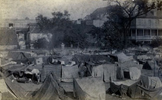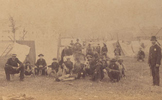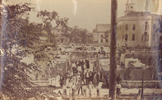In 1886, the city health detective was Francis Nipson. He and his four sanitary inspectors were empowered to inspect public and private buildings and to impose quarantines on places where patients with contagious diseases lived. This job, of course, grew far more difficult—and far more important to life and health—when the August 31 quake suddenly turned most of the city into a refugee encampment.
City authorities worried that epidemics would break out, including cholera, typhoid, and the dreaded yellow fever. This was not an irrational fear: even in normal times, these scourges could bring a city to its knees. As it turned out, there were no epidemics in Charleston in the aftermath of the quake, either because city authorities were vigilant or because they were lucky.
As the months wore on and the casualties mounted, doctors often noted “exposure” as a contributing factor, though it’s hard to see how exposure to the elements could be fatal in a month like September 1886 when temperatures hovered in the eighties and there was very little rainfall. Most entries for deaths occurring in the two months after the earthquake listed a primary cause of death, like fever, congestion of the lungs, cholera, colds, whooping cough, pneumonia, bronchitis, measles, malaria, gastritis, enteritis, gastroenteritis, debility, “dentition” (or teething), “scrofula” (or tuberculosis), epilepsy, mental aberration, liver inflammation, and of course, shock. A typical notation looked something like this: “Epilepsy-Exposure-Earthquake.”



